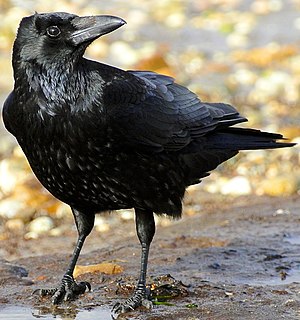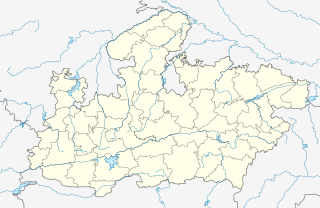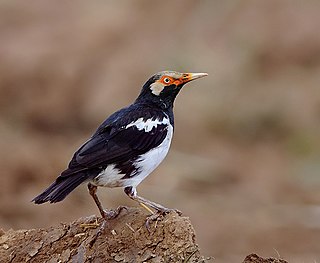Pied myna has been split into three species:
- Indian pied myna, Gracupica contra
- Siamese pied myna, Gracupica floweri
- Javan pied myna, Gracupica jalla
Pied myna has been split into three species:

A raven is any of several larger-bodied bird species of the genus Corvus. These species do not form a single taxonomic group within the genus. There is no consistent distinction between "crows" and "ravens", and these appellations have been assigned to different species chiefly on the basis of their size.

Starlings are small to medium-sized passerine birds in the family Sturnidae. The name "Sturnidae" comes from the Latin word for starling, sturnus. Many Asian species, particularly the larger ones, are called mynas, and many African species are known as glossy starlings because of their iridescent plumage. Starlings are native to Europe, Asia and Africa, as well as northern Australia and the islands of the tropical Pacific. Several European and Asian species have been introduced to these areas as well as North America, Hawaii and New Zealand, where they generally compete for habitats with native birds and are considered to be invasive species. The starling species familiar to most people in Europe and North America is the common starling, and throughout much of Asia and the Pacific, the common myna is indeed common.

The myna is a bird of the starling family (Sturnidae). This is a group of passerine birds which are native to southern Asia, especially India, Pakistan and Bangladesh. Several species have been introduced to areas like North America, Australia, South Africa, Fiji and New Zealand, especially the common myna which is often regarded as an invasive species. It is often known as "Selarang" and "Teck Meng" in Malay and Chinese respectively in Singapore, due to their high population there.
Pied flycatcher may refer to:

The common myna or Indian myna, sometimes spelled mynah, is a bird in the family Sturnidae, native to Asia. An omnivorous open woodland bird with a strong territorial instinct, the common myna has adapted extremely well to urban environments.

A crow is a bird of the genus Corvus, or more broadly a synonym for all of Corvus. The word "crow" is used as part of the common name of species including:

Bandhavgarh National Park is a national park of India, located in the Umaria district of Madhya Pradesh. Bandhavgarh, with an area of 105 square kilometres (41 sq mi), was declared a national park in 1968 and then became Tiger Reserve in 1993. The current core area is spread over 716 square kilometres (276 sq mi).

The Indian pied myna is a species of starling found in the Indian subcontinent. They are usually found in small groups mainly on the plains and low foothills. They are often seen within cities and villages although they are not as bold as the common myna. They produce a range of calls made up of liquid notes.

Thale Ban National Park is a forested area south of the Banthat Mountains in southern Thailand, in the south of Satun Province bordering Malaysia; it borders Taman Negeri Perlis park. The park was established on 27 October 1980. It covers an area of 196 square kilometres of Khuan Don and Mueang Satun districts.

Grackle is the common name of any of 11 passerine birds native to North and South America. They belong to various genera in the icterid family. In all the species with this name, adult males have black or mostly black plumage.

The pied starling or African pied starling, is a bird endemic to South Africa, Lesotho and Swaziland. It is common in most of its range, but largely absent from the arid northwest and the eastern lowlands of South Africa. It is found in open habitats such as grassland, karoo scrub, thornbush and agricultural land, and often associates with farm animals.

The bank myna is a myna found in the northern parts of South Asia. It is smaller but similar in colouration to the common myna, only differing in having brick-red naked skin behind the eyes instead of yellow. It is greyer on the underside and in this and in the presence of a slight tuft of feathers bears some resemblance to the jungle myna. They are found in flocks on the plains of northern and central India, often within towns and cities. Their range appears to be extending southwards into India. The name is derived from their habit of nesting almost exclusively in the earthen banks of rivers, where they excavate burrows and breed in large colonies.

The black-collared starling is a species of starling in the family Sturnidae. Its plumage is black and white, with a black collar. It is found in southern China and most of mainland Southeast Asia, and has been introduced to Taiwan, Malaysia and Singapore. Its habitats include grassland, dry forest and human settlements. The International Union for Conservation of Nature (IUCN) has assessed it as being of least concern.

Gracupica is a genus of Asian birds in the family Sturnidae. It is sometimes merged with Sturnus or Sturnia.

Sturnia is a genus of Asian birds in the family Sturnidae. It is sometimes merged with Sturnus.
G. robusta may refer to:
White-browed shrike-babbler has been split into four species:

Bali Bird Park, is a tourist attraction in Bali, Indonesia. It is located at the Gianyar Regency and has an area of 2,000 square metres. The Bird Park houses more than 1.000 birds representing more than 250 species in an enclosed aviary.

The Siamese pied myna is a species of starling in the family Sturnidae. Its plumage is black and white, with a black collar. It is found in Myanmar and China to Thailand, Laos, and Cambodia. It previously was considered a subspecies of the pied myna, which has now been split into three species. It can be distinguished from the Indian pied myna and Javan pied myna by more extensive white streaking on its forehead from both and a wider extent of bare red-orange facial skin around the eye compared to G. contra, but much less compared to G. jalla.

The Javan pied myna is a species of starling in the family Sturnidae. Its Indonesian name is jalak suren. Its plumage is black and white, with a black collar. It was found in most of Java and Bali and formerly in southern Sumatra. Due to mass collection for the illegal wildlife trade and heavy pesticide use in the agricultural lands it used for feeding, it is now feared to be extinct in the wild.